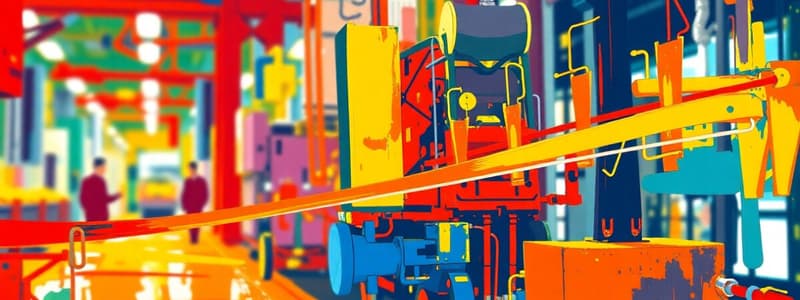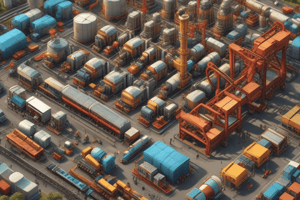Podcast
Questions and Answers
What is the primary purpose of line balancing in operations management?
What is the primary purpose of line balancing in operations management?
- To reduce the number of workstations
- To increase the cost of production
- To eliminate all workstations
- To ensure workflow is efficient and balanced (correct)
An unbalanced line can lead to reduced overall production output.
An unbalanced line can lead to reduced overall production output.
True (A)
What happens at a bottleneck in production?
What happens at a bottleneck in production?
It slows down the entire production line.
A workstation is designed to enhance __________, safety, and productivity.
A workstation is designed to enhance __________, safety, and productivity.
Match the following workstations with their tasks:
Match the following workstations with their tasks:
Which of the following is a feature of a workstation?
Which of the following is a feature of a workstation?
Every workstation must have the same tools, machinery, and materials.
Every workstation must have the same tools, machinery, and materials.
What is the effect of a workstation remaining idle?
What is the effect of a workstation remaining idle?
What is the first step in workstation demand analysis according to the content?
What is the first step in workstation demand analysis according to the content?
The cycle time is found by determining the shortest task time.
The cycle time is found by determining the shortest task time.
What is the formula for calculating efficiency based on the given content?
What is the formula for calculating efficiency based on the given content?
The performance time for task A (Roll Dough) is __________ seconds.
The performance time for task A (Roll Dough) is __________ seconds.
Match the task elements with their performance times:
Match the task elements with their performance times:
Which workstation has the longest task time?
Which workstation has the longest task time?
What is the line efficiency for product A?
What is the line efficiency for product A?
To satisfy a new demand of 60 units per hour, the workstation needs to be more efficient.
To satisfy a new demand of 60 units per hour, the workstation needs to be more efficient.
Downtime for making product B is less than 60 minutes.
Downtime for making product B is less than 60 minutes.
What are the performance times of tasks E and F in the pizza making process?
What are the performance times of tasks E and F in the pizza making process?
How many pieces of product A need to be produced per shift?
How many pieces of product A need to be produced per shift?
The available production time for product A is calculated in ______ minutes per day.
The available production time for product A is calculated in ______ minutes per day.
What is a bottleneck in a supply chain?
What is a bottleneck in a supply chain?
What is the standard time for making product B?
What is the standard time for making product B?
Required cycle time is the minimum time allowed at each workstation.
Required cycle time is the minimum time allowed at each workstation.
Match the tasks with their performance times:
Match the tasks with their performance times:
Define lead time in the context of manufacturing.
Define lead time in the context of manufacturing.
To produce 40 units of products per day, there is no downtime accounted for.
To produce 40 units of products per day, there is no downtime accounted for.
The maximum time allowed at each station is known as __________.
The maximum time allowed at each station is known as __________.
If the machine’s standard time in making product A is 300 seconds per piece, how many machines are needed to meet the daily demand?
If the machine’s standard time in making product A is 300 seconds per piece, how many machines are needed to meet the daily demand?
Match the following concepts with their definitions:
Match the following concepts with their definitions:
What is the primary goal of line balancing?
What is the primary goal of line balancing?
Overburdened workers at bottleneck stations do not experience stress and fatigue.
Overburdened workers at bottleneck stations do not experience stress and fatigue.
What is the impact of a disrupted workflow on customer satisfaction?
What is the impact of a disrupted workflow on customer satisfaction?
What is the formula to compute the output capacity (OC)?
What is the formula to compute the output capacity (OC)?
Efficiency can be calculated by dividing the total task time by the product of the cycle time minimum and the number of workstations.
Efficiency can be calculated by dividing the total task time by the product of the cycle time minimum and the number of workstations.
What is the first step in solving for workstation cycles?
What is the first step in solving for workstation cycles?
The formula for calculating the new cycle time based on daily demand is $CT_{new} = \frac{APT}{OC_{new}}$ where APT stands for __________.
The formula for calculating the new cycle time based on daily demand is $CT_{new} = \frac{APT}{OC_{new}}$ where APT stands for __________.
Match the following terms with their definitions:
Match the following terms with their definitions:
Which of the following best describes a bottleneck in a production line?
Which of the following best describes a bottleneck in a production line?
The sum of task times for workstations should be equal to or greater than the new cycle time.
The sum of task times for workstations should be equal to or greater than the new cycle time.
What is the purpose of calculating the minimum number of workstations?
What is the purpose of calculating the minimum number of workstations?
Flashcards
Precedence Diagram
Precedence Diagram
A visual representation of task relationships in a process, showing the order in which tasks must be completed. It uses arrows to indicate dependencies.
Bottleneck
Bottleneck
The workstation or task with the longest processing time, limiting overall production rate.
Cycle Time Minimum (CTmin)
Cycle Time Minimum (CTmin)
The longest task time in a process, determining the maximum output capacity.
Output Capacity (OC)
Output Capacity (OC)
Signup and view all the flashcards
Efficiency
Efficiency
Signup and view all the flashcards
CT New
CT New
Signup and view all the flashcards
Workstation Minimum (WSmin)
Workstation Minimum (WSmin)
Signup and view all the flashcards
Line Balancing
Line Balancing
Signup and view all the flashcards
Required Cycle Time (Takt Time)
Required Cycle Time (Takt Time)
Signup and view all the flashcards
Lead Time
Lead Time
Signup and view all the flashcards
Task Precedence
Task Precedence
Signup and view all the flashcards
Idle Time
Idle Time
Signup and view all the flashcards
Productivity
Productivity
Signup and view all the flashcards
Line Balancing (Goal)
Line Balancing (Goal)
Signup and view all the flashcards
Line Balancing (Benefit)
Line Balancing (Benefit)
Signup and view all the flashcards
Workstation
Workstation
Signup and view all the flashcards
Assembly Line
Assembly Line
Signup and view all the flashcards
Unbalanced Line
Unbalanced Line
Signup and view all the flashcards
Effects of Unbalanced Line
Effects of Unbalanced Line
Signup and view all the flashcards
What are the disadvantages of an unbalanced line?
What are the disadvantages of an unbalanced line?
Signup and view all the flashcards
Bottleneck Task
Bottleneck Task
Signup and view all the flashcards
Cycle Time (CT)
Cycle Time (CT)
Signup and view all the flashcards
Workstation Assignment
Workstation Assignment
Signup and view all the flashcards
Task Time
Task Time
Signup and view all the flashcards
Precedence Relationship
Precedence Relationship
Signup and view all the flashcards
Line Efficiency
Line Efficiency
Signup and view all the flashcards
Available Production Time
Available Production Time
Signup and view all the flashcards
Standard Time
Standard Time
Signup and view all the flashcards
Calculate Takt Time
Calculate Takt Time
Signup and view all the flashcards
Number of Machines Required
Number of Machines Required
Signup and view all the flashcards
Level Scheduling
Level Scheduling
Signup and view all the flashcards
Procedure for Level Scheduling
Procedure for Level Scheduling
Signup and view all the flashcards
Study Notes
Operations Management Module 17: Line Balancing
- This module covers the concept of line balancing in operations management.
- Learning Outcomes include: understanding the concept of line balancing, evaluating its importance in manufacturing, determining the effects of balanced and unbalanced lines in production, and calculating and applying balancing techniques.
- A workstation is a designated area in a workplace, organized for a specific task. It's a physical space and functional setup to enhance efficiency, safety, and productivity. Workstations should have the tools, machinery, and materials needed for their tasks. Workstation design should also consider ergonomics to reduce worker fatigue, enhance comfort and minimize injury risks.
- An assembly line is a production process where a product is assembled sequentially as it moves through workstations. A specific task is performed at each station to progressively add components or perform operations until the final product is completed.
Unbalanced Line
- An unbalanced line has workstations with uneven task times.
- This leads to a bottleneck, where workstations with excessive tasks slow down the entire production line.
- Workstations with fewer tasks or faster completion rates become idle, wasting time and resources.
- The overall production output decreases since the line doesn't operate at optimal efficiency.
- Overburdened workers experience stress and fatigue.
- Disrupted workflow can cause failures in meeting production deadlines.
Balanced Line
- A balanced line promotes one-piece flow.
- It avoids overburden and minimizes waste.
- It also reduces variations.
- Workstations have approximately equal requirements.
Line Balancing
- Line balancing in manufacturing levels the workload across all processes in a cell or value stream.
- This method helps remove bottlenecks and excess capacity.
- The process involves assigning tasks to workstations to ensure approximately equal requirements.
Concept of Line Balancing
- Bottleneck: The workstation taking the longest time. A delay at this station slows down the production rate. A bottleneck is a constraint in a supply chain.
- Required Cycle Time/ Takt Time: The maximum amount of time allowed at each station, calculated by dividing the required units by the production time available per day.
- Lead Time: The latency between the initiation and completion of the process
- Task Precedence: The product cannot be moved to the next station until it completes the task at the previous station. This shows the order of tasks and their restrictions.
- Idle Time: A period when the system is not in use but is available.
- Productivity: Defined as the ratio of output over input. Factors such as workers' skills, job methods, and machines used impact productivity.
Steps in Solving Line Balancing Problems
- Draw the precedence diagram: Visual representation showing the sequence of tasks and the dependence between tasks.
- Identify the bottleneck or cycle time (CT) minimum: This is the longest task time.
- Compute the output capacity (OC): Calculation to determine the production rate based on the available production time and the minimum cycle time.
- Calculate the efficiency: Calculation for evaluating the efficiency of the existing product.
- Calculation of the new cycle time (CT): Calculation to determine the new cycle time based on daily demand.
- Calculate the minimum number of workstation and assign the task: Determination of required minimum workstations and task assignment to each workstation.
- Draw the updated precedence diagram: Updated visual representation of the tasks and workstations.
- Evaluate the efficiency: Analysis of the updated efficiency levels.
Example and Review
- Examples include numerical examples with tasks, times, and precedence relations for practical application of the line balancing techniques.
- Detailed calculation and analysis steps.
- Review problems focus on calculating available production times, takt times, determining number of machines needed, and calculating efficiency.
Studying That Suits You
Use AI to generate personalized quizzes and flashcards to suit your learning preferences.




